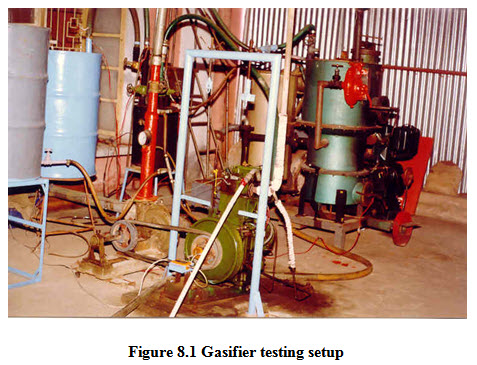Site pages
Current course
Participants
General
Module 1. Design and operational parameters
Module 2. Performance evaluation and maintenance a...
Module 3. Performance evaluation and maintenance a...
Module 4. Performance evaluation and maintenance a...
Module 5. Performance evaluation and maintenance a...
Module 6. Performance evaluation and maintenance a...
Module 7. Biodiesel utilization in CI engines
Lesson 8. Performance evaluation of gasifiers
Performance evaluation of gasifier has to be carried out to assess the thermal efficiency, gas production rate, energy output etc. of the gasifier.
1. Start up of the gasifier
Small amount of ignited charcoal will be placed in the bottom of the gasifier and further feed material will be added. The blower connected with the gasifier will be was turned on and air is supplied into the reactor. Air supply was regulated by regulating valves and measured using rotameters before entering into the reactor. This initiates the gasification. The reactor is closed for providing conducive environment with higher temperature and proper oxygen supply. Instead of using charcoal, LPG torch system can be used to ignite the bed of feed material.
2. Air requirement
The air requirement for gasification of fuel materials can be calculated by calculating the stoichiometric air requirement for complete combustion and equivalence ratio (ER) adopted. Stoichiometric air requirement is calculated from the following formula.
2.7 C + 8 H2 + S – O2
QC = --------------------------
0.23
where
QC – Stochiometric air supply, kg of air / kg of feed material
C, H, S and O - elemental composition of carbon, hydrogen, sulphur and oxygen, per cent
QG = ER x QC
where
QG - Gasification air supply, kg of air / kg of feed material
ER – Equivalence ratio
AF = QG x F
where
F - Feed rate, kg h-1
The producer gas was taken out from the reactor and passed through the cleaning systems. The tar, char, dust and carryover particles were collected and the clean gas was brought down to the burner system for thermal applications or to the engines.

3. Instrumentation
The methods and instrumentation used for measuring various parameters in the study are given below.
3.1 Flow measurement
Airflow rate to the reactor was measured using rotameters. The flow rate of outlet producer gas was measured using a sharp-edge orifice meter, the most widely employed flow-measuring element.

where
Cd - Coefficient of discharge
A1f - pipe cross-sectional area, m2
A2f - orifice cross-sectional area, m2
p1, p2 - static pressures, Pa
ρg - density of gas, kg m-3
3.2 Temperature measurement
Temperature readings at various zones such as drying, pyrolysis, oxidation and reduction zones are measured using K-type thermocouples, which can be connected with digital indicators or recorder with data loggers.
3.3 Gas composition
Composition of generated producer gas was analyzed using gas chromatograph.
4. Performance results
From the gasification results, parameters such as gas yield (Nm3 kg-1), specific gas production (Nm3 m-2 h-1), calorific value (kCal/Nm-3) and hot gas efficiency (%) can be calculated as per the methods given below.
4.1 Gas yield
The gas yield (Gy) was found out from the flow rate of producer gas (Qt) and feed consumption rate (Fr). The formula used was given below.
Qt
Gy, Nm3 kg-1 =----------
Fr
4.2 Specific Gasification Rate
Specific gasification rate (SGR) was calculated using the weight of dry rice husk gasified for a run, net operating period and the cross sectional area of the reactor using the following relation.
Weight of feed material used, kg h-1
SGR= ----------------------------------------------
Cross sectional area of the reactor, m2
4.3 Specific Gas Production Rate
Specific gas production rate is the rate of producer gas generation at STP per unit cross-sectional area of the gasifier.
Rate of gas production, m3 h-1
SGPR = ----------------------------------------------
Cross sectional area of the reactor, m2
4.4 Calorific value of producer gas
Calorific value of producer gas (CVPG) was calculated based on the composition such as CO, CO2, CH4, H2, N2, O2 and water. The procedure followed in calculating calorific value of producer gas is:
Σ Xi CVi
CVPG, kCal Nm-3 =--------------
Z
where
Xi - mole fraction of ith component of gas
CVi - calorific value of ith component of gas
Z = Compressibility factor = 
4.5 Hot gas efficiency
The performance of the gasifier was determined by calculating hot gas efficiency of the reactor system. Hot gas efficiency was found out as follows.
Qt x CVPG
ηH, % =-------------- x 100
Fr x CVF
where
CVPG - calorific value of producer gas, MJ/Nm-3
CVF - fuel calorific value, MJ/Nm-3